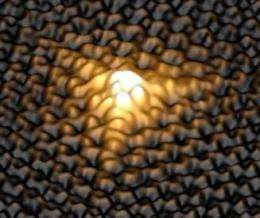March 22, 2010 feature
Physicists create carbon magnetism by removing atoms from graphite

(PhysOrg.com) -- Physicists have found that, by removing individual atoms from a graphite surface, they can create local magnetic moments in the graphite. The discovery could lead to techniques to artificially create magnets that are nonmetallic and biocompatible, as well as cheaper and lighter than current magnets.
The scientists, Miguel Ugeda, Ivan Brihuega, and José Gómez-Rodríguez, all from the Autonomous University of Madrid, along with Francisco Guinea from the Institute of Materials Science of Madrid, have published the results of their study in a recent issue of Physical Review Letters.
“It is a pressing challenge of nanotechnology to be able to integrate graphene in real electronic devices,” Brihuega told PhysOrg.com. “To this end, it is mandatory to understand how the presence of single atomic defects modifies its properties. In our work, we use a scanning tunneling microscope in ultra-clean environments to address such a fundamental question for a graphene-like system, a graphite surface. Our main result is our capability to examine at the atomic scale the intrinsic impact that each single carbon atom removed from the surface has in the electronic and magnetic properties of the system.”
As the scientists explain, creating atomic vacancies in graphene-like materials by removing atoms has a strong impact on the mechanical, electronic, and magnetic properties of the materials. In previous studies, researchers have investigated the effects of atomic vacancies on the properties of the material as a whole. In the current study, the scientists wanted to probe deeper and see what happens at each individual vacancy.
In their experiments, the physicists used highly ordered pyrolytic graphite, which consists of stacked graphene sheets that follow the AB-AB stacking sequence. This means that one graphene sheet (B) is slightly shifted with respect to the upper layer (A) in such a way that half of the carbon atoms of the upper sheet A have a carbon atom located exactly below them, while the other half do not.
First, the researchers peeled off some upper graphene sheets in ultra-clean environments in order to ensure that the top graphene sheet, i.e. the graphite surface, was completely free of impurities. Then they created single vacancies by applying low-energy ion irradiation, using just enough energy to displace the surface atoms and produce atomic point defects.
Using a homemade low-temperature scanning tunneling microscope, the scientists could identify the presence of a sharp resonance peak on top of individual vacancies. The resonance peaked around the Fermi level, which has been predicted in many theoretical studies but has never been experimentally observed before now.
As the scientists explain, the resonance at a vacancy can be associated with a magnetic moment. The vacancies cause nearby electron spins to align due to repulsive electron-electron interactions, which leads to the formation of the magnetic moments. In addition, vacancies at different sites induce different kinds of magnetic moments, which can interact with each other. This interaction points to the possibility of inducing a macroscopic ferromagnetic state in the entire graphite material simply by removing random individual carbon atoms.
“In a pristine carbon system, one would never expect to find magnetism because of the tendency of its electrons to couple in pairs by forming covalent bonds,” Brihuega explained. “The association of electrons in pairs runs against the existence of a net magnetic moment, since the total spin of the electronic bond will be zero. By removing one carbon atom from the graphite surface, what we do precisely is to break these covalent bonds and as a result we create a localized state with a single unpaired electron that will generate a magnetic moment.”
Overall, the results not only confirm the accuracy of theoretical models, but also have further implications. For example, the observed resonances may enhance graphene’s chemical reactivity. In terms of applications, the results could lead to innovative magnets.
“To create a magnet from a pure carbon system is a tantalizing possibility since this would be a metal-free magnet and thus optimal for applications in biomedicine,” Brihuega said. “In addition, it should be much cheaper to produce than conventional magnets since, to give some numbers, a ton of carbon costs around a thousand times less than a ton of nickel ($16 vs. $16,000), a commonly used material in actual magnets. In the case of graphene systems, one would also have flexibility and lightness as additional advantages; but to date, the total magnetization reported for these systems is very low when compared with the strongest existing magnets.
“In my opinion,” he added, “the brightest future in terms of applications stems in the emerging field of spintronics, i.e. in trying to exploit the 'spin' of the unpaired electron for creating new spin-based devices.”
More information: M. M. Ugeda, I. Brihuega, F. Guinea, and J. M. Gómez-Rodríguez. “Missing Atom as a Source of Carbon Magnetism.” Physical Review Letters 104, 096804 (2010). DOI:10.1103/PhysRevLett.104.096804
Copyright 2010 PhysOrg.com.
All rights reserved. This material may not be published, broadcast, rewritten or redistributed in whole or part without the express written permission of PhysOrg.com.



















